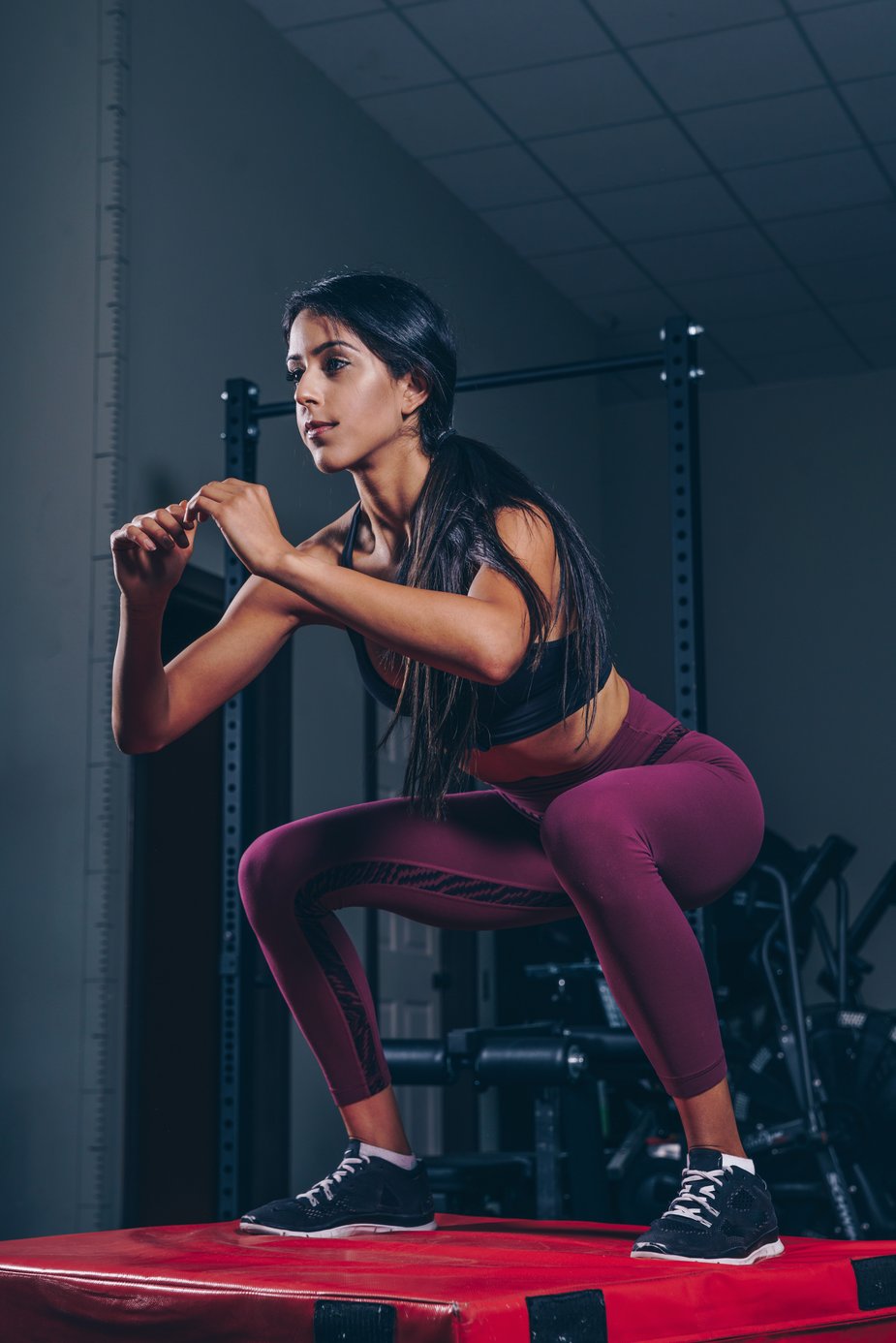
Although squatting is an essential human movement that we should all ideally be able to perform with ease, the majority of our modern Western bodies are significantly “squat-challenged”. There are many different areas of the body that can restrict our range of motion in a squat but one that commonly comes into play is the calves. With this in mind, many of us have incorporated a regular practice of calf-stretching into our routines, which is an excellent movement choice! However, the most common methods of calf-stretching mainly target only the most superficial calf muscles. To truly improve our squat, we need to be sure to include movements that access our deeper calf muscles as well.

The calves consist of the muscles that line the back of the lower leg. When they contract, they point the feet (also called “plantarflexion” of the ankle joint in anatomy speak). The opposite direction of movement of plantarflexion is “dorsiflexion”, in which the top of the foot moves toward the shin. When calf muscles lack flexibility (as they do in so many of us!), they will restrict the ability to dorsiflex.
What does this have to do with squatting? Well, if you picture a person sitting in a full squat with heels on the ground, you can see that their ankle needed to move into a good amount of dorsiflexion in order for this position to be achieved. But what happens when our calves do not lengthen very far? In this case, in order to squat we will make one of two compensations in order to get down into the pose: 1) heels lift and you balance on the balls of your feet in the squat, or 2) feet turn out and angle away from the midline. Both of these strategies allow us to bypass the need to significantly dorsiflex our ankles in our squat. But if our goal is to one day achieve a full squat with our heels down and feet in parallel (and why wouldn’t we aim for this excellent goal?), stretching our calves to increase range of motion in dorsiflexion should be a huge priority.
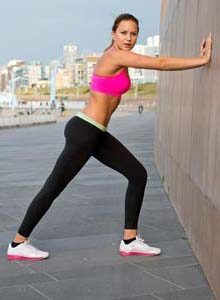
However, when deciding how to stretch our calves, we need to think beyond the ankle joint alone. The largest and most superficial calf muscle is the gastrocnemius and crosses at two joints – the ankle joint and the knee joint. You may know the gastrocnemius as the prominent “two-headed” calf muscle that can sometimes be observed on people with particularly defined calves (Think road cyclists and avid runners). Because this muscle crosses two joints, we need to both dorsiflex our ankle and extend (i.e. straighten) our knee to stretch it. This is coincidentally the way most calf stretches are done. Think of the classic “runner’s lunge” in which one foot is forward, the other is behind, and we lean forward and press our hands into a wall. Yoga’s downward facing dog pose (adho mukha svanasana) is another perfect example of a stretch for gastrocnemius.
But there is a deeper calf muscle called the soleus that is not lengthened when we work with these straight-legged stretches. While the soleus and gastrocnemius share a common distal attachment on the calcaneus (heel bone), the gastrocnemius attaches high up on the femur and the soleus attaches lower down on the tibia and fibula (lower leg bones). So while the gastrocnemius is a two-joint muscle that acts on both the ankle and knee, the soleus is a single-joint muscles that crosses only the ankle.
Improving your squat requires that you have adequate flexibility in both gastrocnemius and soleus. But in order to stretch the soleus, we need to dorsiflex our ankle while the knee is flexed, not extended. This is because if we try to stretch soleus with an extended knee, the more superficial muscle tissue of gastrocnemius will stretch first, preventing the stretch from layering down to the deeper soleus. In order to truly stretch and strengthen our soleus, we must first slacken the overlying gastrocnemius by flexing the knee.
Calf stretches with bent knees are harder to come by than straight-legged ones, however, and there are few (if any) to be found in traditional yoga asanas. Stay tuned for Part 2 of this blog post on Friday in which we’ll look at a few great ways to effectively target soleus, the key to our amazing full squat!




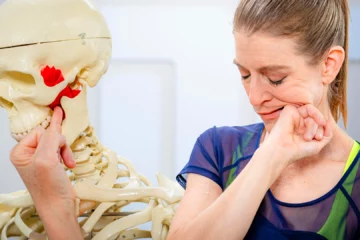
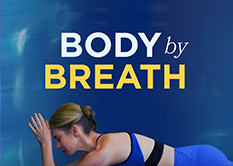



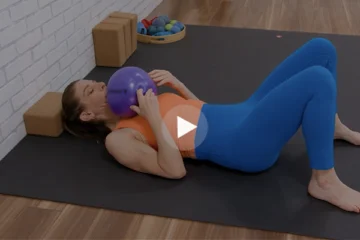
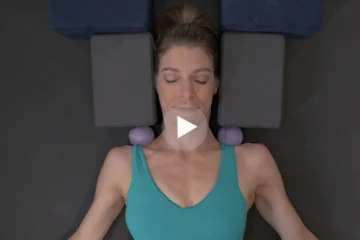


Oh … I realize that I am not stretching and massaging my calves enough … To add to my routine!
Very comprehensive description of the gastrocnemius and Soleus and the impact of knee flexion or extension on their respective stretch.
I’m sorry I didn’t read this much sooner. I’ve spent years working on this with traditional calf stretches with no knee flection and have come no closer to my squat, causing me to not squat much because I don’t want to cement improper patterns.
Knowing about our anatomy can help us better understand how our body works. And as you said, just by creating dorsiflexion it doesn’t mean we are targeting the specific muscles we intend to. Lately I have been thinking about the importance of our ability to dorsiflex our feet for doing Malasana (aka squatting). Sometimes when we think of the pose we try to figure out what’s happening on our spine or hips but take for granted the placement and effort required from the ankles and feet. Re-discovering the feet makes a lot a sense since they are our movers and primary support. Thanks for sharing!
Thank you for helping me visualize what really happens in the calf with various stretches. I am going to concentrate a lot more on stretching the Soleus as I now realize how little I am flexing the knee to get into that muscle. Hopefully I will see a vast improvement in my squats due to better dorsiflexion going forward.
Its back squat day today in the gym and as I write this reply, I am thinking about hopping to getting dressed early and getting to class with ample time to work some foot and ankle mobility work to see if that makes my squat feel better today. I will give some extra love to soleus today and see how it feels. My biggest feat as my mobility got better in CrossFit was losing my “crutch”- my weightlifting shoes, and being able to squat in my normal shoes. Taking away that help into dorsiflexion to achieve my full squat over A LOT of time really showed me how our bodies adapt to regular movement patterns and create new pathways for movement when shaped and repeated into our nervous system! Anyone who is a lifter out there and new to that domain, work your mobility and try not to rely on lifting shoes!!
Thank you! This sentence was like a light-bulb for me: “if we try to stretch soleus with an extended knee, the more superficial muscle tissue of gastrocnemius will stretch first, preventing the stretch from layering down to the deeper soleus.” This one sentence gives me a better understanding of how to think about targeting a specific muscle, not just in stretching but in strengthening exercises.
That poor soleus is often overlooked it seems! I wonder how many people have issues that fail to target the muscles and tissues that actually need the work. Grateful for such a knowledgable community that can help the people who love to move do it to the best of their ability.
Squat has never come easy for me and it may be that my soleus need more attention. I also love learning and thinking about the gastrocnemius as a 2 joint muscle. I can’t wait to read the next article!
Squatting and working with dorsi-flexion are both powerful functional exercises to working with elderly clients. The ability to dorsi-flex will allow them to pick up their feet, thereby reducing falls. And squatting is valuable to help them lower themselves to the toilet! Soleus for Seniors!
In breaking down the DOM’s of a squat to wrap my head around it, I neglected to consider just how crucial both the soleus and gastrocnemius are to fully inhabiting the pose. A light bulb moment thank you!
This was so interesting! Another reason yoga is good for runners.
Needed to be reminded Thank you !
Great information, I never new that to target the m. Soleus in a calf stretch you need to keep the knee flexed!
Thank you Jenni, this is an extremely helpful article for me. I was doing my first squat about 5 years ago, aged 34, and having been a dancer in my childhood, squatting did and does not come easy to me (bending knees without externally rotating my legs… 😉 ) . My calves always feel stiff and dense and even though I could increase their suppleness over the years, my squat is still inadequate and negatively affecting my hips. I am very happy to read about alternative stretching methods for the calves here!
This is a nice breakdown of the gastrocnemius and soleus, I always get those two mixed up and find it difficult to get my head around their differences. thanks for sharing.
Soleus is a key muscle i keep forgetting to stretch. Thank you for the great insight of the limitation at hand when not taking soleus into play. Thank You
Thank you SO much for this great article!!! I always have calf pain ( I wore heels in my 20s-bye dorsiflexion! ) and and No wonder I love Downward facings dog! and still got the tirst to stretch my lower calf part! I WANT full squart!! Heading to read the next one!
Love this article! Thank-you Jenni!
I have heard time and time again that in order to increase your squat depth, you need to look after the calves, but no one was ever able to fully explain why, but you just did! Gastro gets all the attention, but can’t forget about the Soleus! This gave me the “lightbulb/Ah-Ha!” moment. Well written.
=:0)
Thanks for writing the article. I recently strained my gastrocnemius muscle from walking on an uneven surface. I also have a really hard time keeping my feet facing forward when squatting. Now I will attend to my soleus muscle as you have suggested.
Great anatomy reminder for a highly neglected muscle.
As a runner and yogi with extremely tight calves, I am looking forward to reading the second instalment! Downward dog with feet flat is always a challenge for me, however with my YTU balls and by focusing on the soleus I hope to get there one day!
A simple stretch for the soleus (and gastroc) that I’ve used is to stand on a step with my heels hanging off the edge; essentially standing on the balls of my feet, heels lower than the actual step. Body weight creates the tension needed for stretch and bending or straightening the knees changes where the stretch is felt. It works best if I hold onto the handrail or wall and ease into the stretch.
My relatively limited dorsiflexion definitely gives me a tough time in the squat. I do this soleus stretch, and using a banded distraction helps me too… along with rolling.
I neglected those poor Soleus and they are thight!
Thank you to bring them back in my mind!
Jenny, thanks for highlighting the often overlooked soleus, and it’s crucial importance in being able to dorsi flex the ankle joint and come to squat .
I use Katy Bowman’s domes with my class already but and shall explore more with the flexed knee option!! Great post thank you.
Great post! I love finding creative ways to stretch more specific muscles. When talking about squats, many students find it difficult to get their heels to the floor, or even to find comfort in the pose (as in Malasana). Taking a little more time in warming the calves is a wonderful way to start to work towards a more effective and pleasant squat.
Thank you for this! The book “Whole Body Barefoot” by Katy Bowman offers a great soleus stretch using a half dome with bent knees that I’ve been using for a while. Although I could feel the stretch navigate from my gastrocnemius to my soleus as I went from extended to flexed knees, I didn’t understand why. Your explanation of the differences in attachments and depth of these muscles really illuminated why flexing the knee makes a difference in the region being stretched.
Whenever I am treating a client and I hit their soleus it almost always sends them off the mat. This is such a neglected muscle!
I often work with students playing with movements such as dorsiflexing the ankle with the knee straight vs bent as a safe exploration of their body that can lead to greater range of motion for them as they practice.
The long lost muscle in the calf. (soleus) I love spending time during my classes to focus on the calves. Students are amazed how much better they feel after the class.
Very interesting article. Muscle often forgotten, I will see not to neglect it
Thanks for this great article Jenni. I can squat fully with straight feet but I am not clear on why it is not ok to squat with the feet pointing out. Is it because it puts some stress on the knees? I would love to know the reason behind this. I spend a lot of time in Asia and I observe so many Asians of all ages squatting with their feet slightly turned out. Hmmmm…. Any thoughts on that? Thanks.
Well I have definitely been cheating out on a proper stretch to perfect my squats when working out. I always end up pigeon toeing out the feet. I also cheat myself of a proper stretch for the calf as I always focus on my quads. This article was very helpful to bring light to how I not only need to stretch my gastronemius, but also need to give some TLC to my soleaus. Thanks for the dorsi flexion que with knee flexion as I would have ended up in knee extension. These minor adjustments are going to bring a whole new amazing experience to my squatting excersise!!
This article is perfect for me. One of my goals for 2017 is to achieve a full squat. I have been working on my calf stretch exercises and dorsiflexion, but I had never heard about getting into the soleus by stretching the calf with my knee flexed. I will definitely add that into my routine moving forward — thank you!
Many people don’t warm up or stretch the calves before moving into downward facing dog and then try to force their heels to the ground. Some people think the goal of downward facing dog is to have their heels resting on the ground and don’t see the benefits of the posture. The soleus muscle can be the culprit in releasing heels while in downward facing dog or lowering into a squat. Finding stretches that will target the soleus can be challenging and therefore I am anxious to read Part II.
I am so glad to have come across this article. I now have a better understand of calf stretch, and the stretch between gastrocnemius and soleus. I have injured my knees a few months ago for reason that I did not know, and I lost my range of motion of squatting. I do notice that if I stretch my calves and roll with the therapy balls, I can squat a little better. I am hopping over to read the next article to learn how the ways to stretch the soleus. Thanks for sharing! Michelle
Great info. Thank you. Now I understand why my heels lift and feet turn out in a squat. Getting right to work on that Soleus. Static monk walk here I come.
Thanks for sharing this useful info! I’ll check out your other blog also and learn some new stretches for the soleus!
Thank you for this fantastic description of the calf muscles, and particularly the importance of the soleus in allowing for the foot dorsiflexion that in turn aids in achieving the full expression of such a natural pose as the deep/full squat. As a runner, I am only too familiar with the “calf struggle”, which is very real. Regular calf maintenance, incl. stretching of both the gatrocnemius and soleus, helps me maintain and further develop my full squat.
This was great and definitely true, find myself only stretching the top of my calf so looking forward to reading the next blog post to learn how to stretch the soleus.
I recently added this soleus stretch to the calf stretch warm-ups I do with my chair yoga class. Now I will have all these added details to explain the how’s and why’s more clearly as we work to improve flexibility in ankle and calf. Thanks for the detailed description and graphics!
Very enlightening and interesting. So Utkatasana should be a good stretch for the soleus along with the cycling pedal stroke with heels down like your scraping mud off of your shoe, correct?
I regularly stretch the calf and hamstring with the knee extended, often flexing the torso for a deep hamstring stretch. I didn’t realize that I was still not targeting the deep soleus muscle of the calf! I can’t wait to try stretching with the flexed knee to see if that improves my deep squat. Thanks for the great article.
Merci pour la description du soleaire et gastrocnemien.
I never realized how bending the knee was necessary to reach the deeper muscles of the calf! It’s good to know, maybe over time I will be able to put my heals down!
I always have my yoga students keep their knees bent on the first few down dogs to go easy on the hamstrings.I had no idea this was helping them stretch their neglected soleus muscle. Yay!
I really love the this stretch. So many just stick with the “runners lunge”. Flexing the knee is the key to getting into the Soleus. Fascinating.
This is really interesting, I never realized the need for a flexed knee calf stretch. I will definitely be paying more attention to my sole us from now on! Thanks.
As a movement educator and yoga teacher who works with athletes and CrossFitters this is extremely helpful as many of them have poor squat form and can’t get their heels down, when they add load this puts them in a precarious situation. Looking forward to part two!!
Great article! The soleus seems like the forgotten muscle of the squat but so essential in order to increase the squat range. I’ll be know spending more time on the soleus!
Thanks for addressing the soleus as it is completely left out by the gastrocnemius. I’m looking forward to reading the next part of this blog as many of my students can’t get their heels down to the floor.
I had never thought about how the knee would need to be flexed in order to stretch the soleus. This is definitely something I will begin doing myself and include in my group classes. It is such a simple adjustment, but makes such a difference.
Although a full Ass to Grass squat is easy for me, it’s def not for everybody. Thank you for addressing the soleous muscle in this article! I didn’t know it was so overlooked!
Jenni so happy you addressed the Soleus Muscle; many people are under the impression that the Gastrocnemius muscle is the only muscles they need to stretch and strengthen. We tend to only pay attention to the muscles that shape our body. Ok who doesn’t like a well- defined calf? In your blog you explain how the traditional calf stretches such as Runners Lunge (which is a yummy stretch) doesn’t target the deeper Soleus. The Gastrocnemius muscle crosses 2 joints the knee and the ankle producing movement at both joints. The Soleus muscle crosses only the ankle joint. Placing the knee in flexion you can take the larger and stronger Gastrocnemius out of the picture and allow just the soleus, which attaches below the knee, to stretch. If the knee remains straight the Gastrocnemius will be the primary muscle stretched. This is just another reason why I love 90 90 Lunges(Static Monk Walk) and squats.
not to mention here the chronic shortening we develop over time from heeled shoes-not even traditional heels, but even small heels present on nearly all sneakers and “flats.” stretching is hugely important but if we dont make changes in footwear, the stretching is just a bandaid and moving around in the heeled shoes will prevent us from ever getting heels to the ground. i think sometimes we all wish it was as easy as doing a few stretches a few days a week, or even every day-but its changes those other 23 hours of the day that make a real impact. not to say that these stretches arent important-nothing happens without that mobilization-but to make true progress and see real change it needs to be paired with lifestyle changes as well.
How much interaction is there between gastroc and soleus? Do they share more fascial connections than the Achilles tendon? While I get that flexing the knee can take some of the influence of the gastroc out of the picture, I expect it varies from person to person. Similarly, I’d think that even with the leg extended, there’d be some stretch for the soleus – based upon the dynamic relationship between soleus and gastroc. I enjoyed your post – I’m just greedy for more.
No wonder I have never gotten to a full squat.. those soleus are stopping me. I have never been able to do a full squat while keeping my feet on the floor without an aid or turning my feet out. I always think of stretching the gastrocneimius but rarely stretch the soleus (our second heart). Definitely going to give this overworking muscle some nice stretches, which will hopefully allow me to get to a deeper stretch. Can you link me to the next article with the stretches for the soleus. I know the basic stretch against a wall with a knee bent and ankle dorsiflexed but would love to have some other ideas.
Much needed, I am working on seeing and understanding, feeling the squat in a new way. I would like to see a video of squat with arms up against the wall as you spoke of in part 2. thanks.
Heading over to part 2 now. You always have great info your articles and videos! I really appreciate it!
Great description of the calf muscles, thank you! I am looking forward to seeing the stretches that can be done to get to the soleus!
As someone with lack of flexibility in my calves, this explains totally explains my struggle with malasana, will definitely be stretching my soleus and gastrocnemius more mindfully from now on!